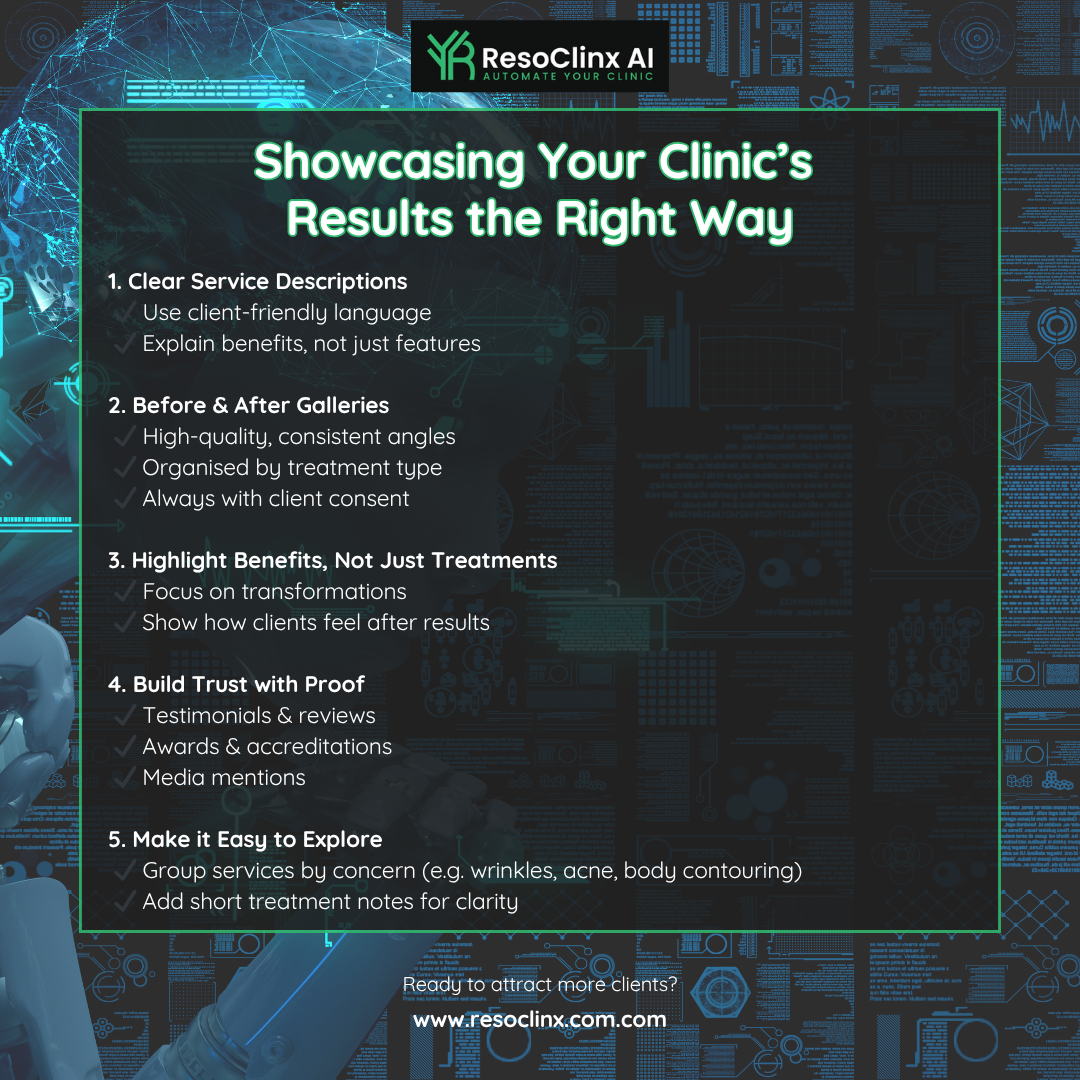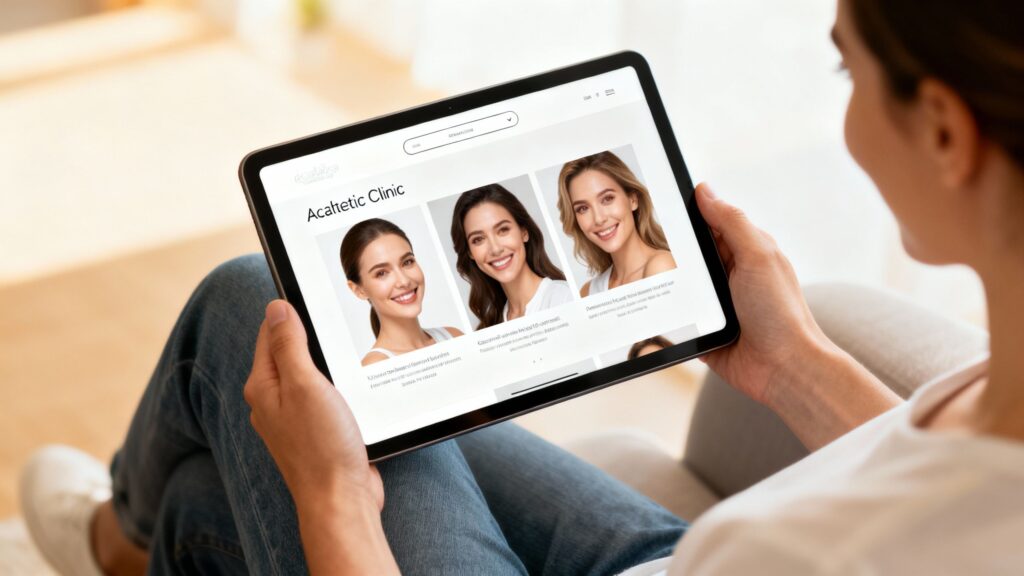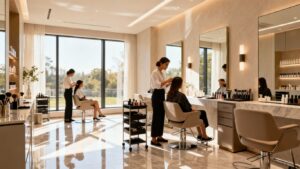Your website is usually the very first impression potential clients have of your aesthetic clinic—and in this industry, that impression is everything. A well-designed site builds trust, reflects professionalism, and gives visitors confidence to book with you.
So, what really makes an aesthetic clinic website stand out from the rest?
In this post, we’ll explore some of the best aesthetic clinic website examples and highlight what they’re doing right. By the end, you’ll have practical ideas you can adapt to make your own site not just beautiful, but highly effective at attracting new clients. Let’s dive in.
Key Takeaways
- Ensure your website looks professional and is easy to navigate. Use high-quality images and simple menus so visitors can quickly find what they need without frustration.
- Build trust by showing off happy clients. Testimonials, before-and-after photos, and even good reviews can make a big difference. People want to see real results and know others have had a good experience.
- Make booking an appointment super simple. A complicated booking process can lose you clients before you even start. Offer online booking or a clear way to get in touch.
- Your website’s words and pictures should match your clinic’s vibe. If you’re calm and relaxing, your site should feel that way too. Keep your branding consistent everywhere you are online.
- A good website works well on phones and tablets. Most people will look you up on their mobile, so make sure your site looks good and loads fast on any screen size.
Crafting an Engaging Online Presence: Key Website Elements

Your clinic’s website is often the first point of contact for potential clients. It’s more than just a digital brochure; it’s a vital tool for building trust and showcasing what makes your practice special. Think of it as your virtual front door.
Making sure it’s welcoming, informative, and easy to use is absolutely key to attracting and keeping clients. A well-designed site doesn’t just look good; it actively works to convert visitors into booked appointments.
Showcasing Expertise Through Visuals
High-quality imagery and video are non-negotiable for an aesthetic clinic. Potential clients want to see the results you achieve and get a feel for your clinic’s atmosphere. This means investing in professional photography and videography that accurately reflects your services and brand.
Think about showcasing:
- Before-and-after galleries are powerful trust-builders. Keep them well-organised, clearly labelled by treatment type, and always use high-resolution images. Be sure you have documented client consent, in line with UK advertising and data protection regulations.
- Clinic Interior Shots: Give visitors a glimpse into your space. Is it modern and sleek, or warm and inviting? This helps set expectations and can make clients feel more comfortable before they even step through the door.
- Team Introductions: Short videos or professional headshots of your practitioners, perhaps with a brief bio, can build a personal connection and highlight their qualifications.
- Procedure Demonstrations: Short, tasteful videos explaining or showing aspects of treatments can demystify the process and educate potential clients.
Visuals should always be professional, tasteful, and aligned with your brand’s overall aesthetic. Avoid anything that looks overly staged or unrealistic; authenticity builds trust.
Prioritising User Experience and Navigation
If a website is difficult to use, people will leave. It’s that simple. A good user experience (UX) means visitors can find the information they need quickly and easily. This involves:
- Intuitive Navigation: A clear, logical menu structure is essential. Key pages like ‘Services’, ‘About Us’, ‘Contact’, and ‘Book Now’ should be easily accessible from every page.
- Clear Layout: Use white space effectively to avoid clutter. Information should be presented in digestible chunks, using headings, subheadings, and bullet points.
- Fast Loading Speed: Slow websites are frustrating. Optimise images and website code to ensure pages load quickly, especially on mobile devices.
- Mobile Responsiveness: A significant portion of users will access your site via their phones. It must look and function perfectly on all screen sizes.
Building Trust with Social Proof
Potential clients are far more likely to trust your clinic when they see real proof of positive client experiences.
- Client Testimonials: Feature genuine reviews from satisfied clients. These can be text-based, video testimonials, or even links to reputable review sites.
- Awards and Accreditations: Display any industry awards, professional body memberships, or certifications prominently. This demonstrates credibility and commitment to quality.
- Media Mentions: If your clinic has been featured in local or national press, include logos or snippets of articles.
- Before-and-After Photos: As mentioned earlier, these are a form of visual social proof, showing tangible results.
By focusing on these core elements, you can create an online presence that not only looks professional but also actively works to attract and convert new clients.
Optimising the Client Journey: From First Click to Booking

Making it easy for potential clients to move from simply browsing your website to actually booking an appointment is absolutely key. Think of your website as the first step in a positive client experience.
If this initial interaction is clunky or confusing, they’re likely to just click away and find someone else. We want to make that journey as smooth as possible, turning interest into a confirmed booking.
Streamlining Appointment Scheduling
This is where many clinics can really improve. A complicated booking system is a major turn-off. Ideally, your website should feature a clear, easy-to-find booking button on every page.
This booking button should link to a system showing real-time availability, allowing clients to book instantly with minimal steps. Many modern systems allow clients to choose their preferred date and time, and even select the specific service they want.
This not only helps the client but also means less administrative work for your team. Some clinics even integrate online payment options or deposit requirements directly into the booking process, which can help reduce no-shows.
- Make the booking button prominent and accessible.
- Offer real-time availability so clients know exactly when they can be seen.
- Allow clients to select their preferred practitioner if you have multiple.
- Consider integrating a system that sends automated appointment reminders via email or text.
Guiding Visitors with Clear Calls-to-Action
What do you want people to do when they visit your site? Do you want them to book a consultation, download a brochure, or call for more information? Whatever it is, make it obvious. Clear calls-to-action (CTAs) are like signposts for your website visitors.
They tell people exactly what the next step is. Instead of just having a generic ‘Contact Us’ button, try more specific CTAs like ‘Book Your Free Consultation Today’ or ‘Discover Our Signature Treatments’.
These are more persuasive and guide the user more effectively.
The language used in your CTAs should be direct and action-oriented. Think about what motivates your potential clients and use that to your advantage. For example, if many clients are concerned about cost, a CTA like ‘Explore Flexible Payment Options’ could be very effective.
Leveraging Technology for Enhanced Engagement
Technology can do more than just facilitate bookings; it can also make your website more engaging and informative. Interactive elements can help clients understand your services better and feel more connected to your brand.
For instance, a ‘virtual consultation’ tool where clients can upload a photo and receive preliminary advice can be a great way to capture leads from people who aren’t quite ready to book in person. Live chat support is another excellent option, allowing potential clients to ask quick questions and get immediate answers, which can be the difference between them booking with you or a competitor.
Some sites even use quizzes or simple questionnaires to help clients identify treatments that might be suitable for their specific concerns, personalising their experience right from the start.
Communicating Value: Tone, Language, and Content Strategy
When potential clients land on your aesthetic clinic’s website, they’re not just looking for pretty pictures; they’re looking for answers and reassurance. How you talk to them, the words you choose, and the overall message you convey can make all the difference between a visitor who clicks away and one who books a consultation. It’s about striking a balance – being professional and knowledgeable, yet also warm and understanding. Think of your website’s language as the digital handshake and the initial conversation you’d have in the clinic.
Adopting a Professional Yet Approachable Tone
It’s easy to fall into the trap of sounding too clinical or, conversely, too casual. The sweet spot for an aesthetic clinic is a tone that’s both authoritative and friendly. You want to convey that you’re experts in your field, capable of delivering excellent results, but also that you’re approachable and genuinely care about your clients’ well-being and goals.
This means avoiding overly technical jargon unless it’s clearly explained, and instead opting for language that’s easy to understand. Imagine you’re explaining a treatment to a friend who’s curious – you’d be informative but also reassuring.
- Be clear and direct: State what you do and how it benefits the client without unnecessary fluff.
- Show empathy: Acknowledge that clients might have concerns or anxieties about treatments.
- Maintain a positive outlook: Focus on the solutions and positive outcomes you can provide.
The goal is to build confidence and trust from the very first interaction online. This means your website should feel like a safe and welcoming space, where clients feel understood and confident in the care they will receive.
Utilising Client-Centric Language
Always shift the focus from ‘we’ to ‘you’. Position treatments around the client’s goals and benefits, not just the clinic’s offerings. This subtle change puts the client’s needs and desires at the forefront.
Think about the problems your clients are trying to solve and the results they’re hoping to achieve. Use language that directly addresses these points.
For example, instead of just listing ‘Botox’, describe it as ‘reducing the appearance of fine lines and wrinkles for a refreshed look’.
Here’s a quick comparison:
| Feature/Service | Clinic-Centric Language | Client-Centric Language |
|---|---|---|
| Botox | We administer Botox. | Smooth away lines and wrinkles. |
| Dermal Fillers | Our filler treatments. | Restore lost volume and enhance your features. |
| Facials | We provide facials. | Reveal radiant, healthy-looking skin. |
Balancing Information with Persuasion
Your website needs to inform visitors about your services, but it also needs to persuade them to take the next step. This involves presenting information in a way that highlights the benefits and value you offer.
Don’t just list treatments; explain why a client would want them. What problem does it solve? What positive change will it bring to their life? Use compelling descriptions that paint a picture of the desired outcome. However, avoid making unrealistic promises. Honesty and transparency are key to building long-term trust.
If a treatment has limitations or potential side effects, it’s better to mention them clearly, perhaps in a dedicated FAQ section or within the service description itself, rather than letting a client discover them later.
- Clearly outline the benefits of each treatment.
- Explain what a client can expect during and after the procedure.
- Use testimonials and before-and-after photos to demonstrate results (with consent, of course!).
- Make it easy for them to find out more or book a consultation.
Designing for Credibility and Longevity

Building a website that lasts means thinking beyond just the current trends. It’s about creating a solid foundation that feels trustworthy and looks good for years to come.
This involves a few key areas that really make a difference in how clients perceive your clinic.
Embracing Timeless Design Principles
When it comes to website design, ‘timeless’ is the goal. This means avoiding overly flashy or trendy elements that will quickly look dated. Think clean lines, plenty of white space, and a clear, easy-to-read font. A design that’s too busy or relies heavily on fleeting fads can actually make a clinic seem less professional. Instead, focus on a layout that’s simple and functional.
A good structure might include a clear hero section, followed by your services, then client testimonials, and a prominent call to action. This kind of straightforward approach is sustainable and will age gracefully.
- Prioritise readability: Use high-contrast text and well-spaced typography. This makes it easy for visitors to find the information they need without straining their eyes.
- Keep it balanced: While a bright, optimistic colour scheme can reflect your clinic’s vibe, ensure it’s balanced with ample white space. This prevents the site from feeling overwhelming.
- Functional visuals: If you use icons, make sure they serve a clear purpose, like providing quick visual cues for service categories. This aids scanning and remains useful as your content evolves.
A website that feels clean, organised, and easy to use builds immediate trust. It suggests that your clinic operates with the same level of care and attention to detail in its services.
Ensuring Mobile Responsiveness and Speed
In today’s world, most people will visit your website on their phone. If your site isn’t easy to use on a small screen, you’re losing potential clients. Mobile responsiveness means your website automatically adjusts its layout to fit any screen size, from a large desktop monitor to a small smartphone.
Beyond just looking good, speed is also incredibly important. Slow-loading websites frustrate visitors, and they’ll often leave before they even see what you have to offer. Aim for fast loading times – ideally under 3 seconds – to keep visitors engaged.
Here’s why this matters:
- First impressions: A slow or poorly formatted mobile site can make a negative first impression.
- Search engine ranking: Google and other search engines favour websites that are mobile-friendly and load quickly.
- Client experience: A smooth, fast experience on any device shows you respect your clients’ time.
Maintaining Security and Compliance
When clients share personal information or book appointments online, they expect that data to be safe. A secure website builds confidence and shows you take privacy seriously. This includes having an SSL certificate (which you’ll see as ‘https’ in the web address) to encrypt data.
Furthermore, UK clinics must comply with GDPR to ensure personal and medical data is protected.
Ensuring your website forms and any online booking systems are secure and compliant is not just good practice; it’s often a legal requirement. This protects both your clients and your clinic from potential issues.
- SSL Certificate: Essential for encrypting data transmitted between the user’s browser and your website.
- Secure Forms: Use secure, encrypted forms for appointment requests or contact submissions.
- Privacy Policy: Clearly outline how you collect, use, and protect client data.
Highlighting Services and Results Effectively

When potential clients land on your clinic’s website, they’re looking for solutions to their aesthetic concerns. It’s your job to show them you have those solutions and that you can deliver great outcomes.
This means being clear about what you do and, more importantly, what results people can expect.
Detailed Service Descriptions and Benefits
Don’t just list treatments—explain them in clear, client-friendly language. Think about what makes each service special and how it directly benefits the client. What problem does it solve? What positive changes can they anticipate?
Using clear, straightforward language is key here. Avoid overly technical terms unless you explain them simply. Focus on the transformation and the feeling clients will have after the treatment.
For example, instead of just saying ‘Botox’, you could describe it as:
- Dynamic Wrinkle Reduction: Smooths out lines caused by facial expressions, giving a more refreshed and youthful appearance.
- Preventative Anti-Ageing: Helps to stop deeper lines from forming by relaxing specific facial muscles.
- Quick and Minimally Invasive: A fast procedure with little to no downtime, perfect for busy schedules.
This approach helps clients understand not just the ‘what’ but the ‘why’ and ‘how’ it will help them.
Presenting Before-and-After Galleries
Visual proof is incredibly powerful in the aesthetics industry. A well-curated before-and-after gallery is one of the most convincing tools you have. High-quality images are non-negotiable. They need to be well-lit, taken from consistent angles, and show genuine results. Ensure you have clear consent from every client featured.
Consider organising your gallery by treatment type or the concern addressed (e.g., ‘Acne Scarring’, ‘Facial Rejuvenation’, ‘Body Contouring’). This makes it easier for visitors to find examples relevant to their own needs. You might even include a brief, anonymised note about the treatment performed and the client’s goals.
| Treatment Type | Before Image | After Image | Notes |
|---|---|---|---|
| Dermal Fillers (Cheeks) | [Image] | [Image] | Restored volume, softened nasolabial folds |
| Laser Resurfacing | [Image] | [Image] | Improved texture, reduced sun damage |
| Anti-Wrinkle Injections | [Image] | [Image] | Smoothed forehead lines, lifted brows |
Tailoring Content to Specific Client Concerns
Think about the different people who might visit your website. They’re not all looking for the same thing. Some might be worried about fine lines, others about acne, and some might be exploring body contouring. Your website content should reflect this diversity.
- Address common concerns directly: Create sections or blog posts that speak to specific issues. For instance, ‘Solutions for Oily Skin’ or ‘Understanding Non-Surgical Facelifts’.
- Use client language: When describing problems and solutions, use the words your clients might use. If they’re searching for ‘turkey neck’, make sure you have content that addresses that concern, even if the technical term is different.
- Showcase relevant testimonials: Feature client feedback that specifically mentions the results they achieved for a particular concern. This adds a personal touch and builds relatability.
By showing that you understand and can address a wide range of client needs, you build confidence and encourage them to take the next step towards booking a consultation.
Building a Cohesive Brand Identity Online
Your clinic’s website is more than just a digital brochure; it’s the first handshake, the initial impression, and the virtual embodiment of your practice. To truly connect with potential clients and stand out in a busy market, your online presence needs to feel like a unified extension of your physical clinic.
This means ensuring that every element, from the colour palette to the tone of your words, consistently reflects your clinic’s ethos and the atmosphere you cultivate in person.
Reflecting Clinic Ethos and Atmosphere
Think about what makes your clinic unique. Is it a serene, spa-like environment focused on relaxation and rejuvenation? Or perhaps a cutting-edge, results-driven clinic that prioritises advanced technology and medical precision? Your website should immediately communicate this.
Use imagery that mirrors your clinic’s interior design, staff uniforms, and overall vibe. If your clinic is known for its calming ambiance, employ soft colours, gentle typography, and perhaps even ambient background sounds (though use these sparingly!). If it’s more about clinical excellence, showcase your state-of-the-art equipment and the professional demeanour of your team.
The goal is to create a digital space that feels familiar and welcoming to someone who has never stepped foot in your clinic before, yet instantly recognisable to a returning client.
Consistent Visual Branding Across Platforms
Brand consistency goes far beyond using your logo everywhere. It’s about creating a cohesive, recognisable look and feel across every digital and in-clinic touchpoint. This includes:
- Logo Usage: Ensure your logo is present and correctly formatted across all digital touchpoints – website, social media profiles, email signatures, and any online advertising.
- Colour Palette: Stick to a defined set of brand colours. These should be used consistently in website design, marketing materials, and even in-clinic signage.
- Typography: Choose a few select fonts that align with your brand personality and use them consistently for headings, body text, and calls-to-action.
- Imagery Style: Whether you use professional photography, illustrations, or stock images, maintain a consistent style that reflects your brand. Avoid a jumble of different visual aesthetics.
Integrating Online Presence with Offline Experience
Your website should act as a bridge, seamlessly connecting the online journey with the in-clinic experience. This means the promises made online should be delivered in person. If your website highlights a particular service as a signature treatment, ensure it’s prominently featured and expertly delivered at your clinic. Similarly, if you offer a specific client care pathway online, make sure your reception and treatment staff are aware and can uphold that standard.
Consider how clients interact with you online versus in person. For instance, if you use a friendly, approachable tone on your website, ensure your staff embody that same warmth when greeting clients. This alignment builds trust and reinforces your brand’s integrity, making clients feel confident and valued at every touchpoint.
A strong brand identity online isn’t built overnight; it’s a continuous effort to ensure that the digital representation of your clinic is an authentic and compelling reflection of the real-world experience you provide. Every click, every scroll, and every interaction should reinforce who you are and what you stand for.
Your Clinic’s Digital Showcase
At the end of the day, your website is more than just a place to list services—it’s where trust begins. The best clinics know how to blend beauty with usability, turning visitors into loyal clients with just a few clicks.
Take inspiration from these examples, borrow what works, and make it your own. Because in a field built on aesthetics, your site shouldn’t just look good—it should work beautifully too.
Frequently Asked Questions
What makes a good aesthetic clinic website?
A really good clinic website is easy to use, looks nice, and makes it simple for people to find out about treatments and book appointments. It should show off the clinic’s expertise with great pictures and explain everything clearly. Think of it like a friendly guide that makes you feel confident about the clinic.
How important are before-and-after photos?
Before-and-after photos are one of the most important trust signals for aesthetic clinics. They act as clear proof that treatments deliver real results. Seeing real results helps potential clients imagine what could happen for them and builds a lot of trust. Just make sure the photos are clear and show genuine transformations.
Should my clinic website work well on phones?
Absolutely! Most people look at websites on their phones these days. If your website isn't easy to use on a small screen, people will likely leave. It needs to look good and work perfectly on any device, whether it's a phone, tablet, or computer.
How can I make my website build trust with visitors?
You can build trust by showing real client reviews and testimonials. Having information about the qualifications of your staff and awards the clinic has won also helps a lot. Making sure your website looks professional and is easy to navigate shows you're serious about what you do.
What's the best way to get people to book an appointment online?
Make the booking button really obvious and easy to find, maybe right at the top of the page. Keep the booking process simple and quick, asking only for the essential information. Offering different ways to book, like a phone number or a contact form, can also help.
How should my clinic's website talk to potential clients?
Your website should sound friendly and helpful, not too stuffy or overly technical. Use words that are easy to understand and focus on how your treatments can help solve the client's problems or achieve their goals. It's like having a helpful chat that explains things clearly and reassures them.






